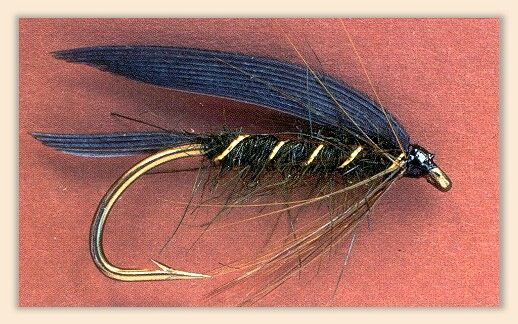Great Canadian Flies
Dark Caddis
By Arthur James Lingren

Caddisflies are one of the world's most abundant aquatic insects.
In the western USA and British Columbia, there are over 300 species
and they outnumber western mayflies and stoneflies combined. Every
fisherman has encountered some of these case-builders which, incidentally,
make their homes from a variety of materials - stone, twigs, or
evergreen needles. For many species of caddisflies, these homes
are "mobile" - that is they are dragged around by the insects
which make them; and, when they are dragged across the mud of
still or slow-moving water, they leave tell-tail trails behind
them. Trout will eat homes and all. But not all caddis build
homes and, anyway, it is the pupa and free-living forms that
are more sought after by Mr. Trout.
Some popular caddis - called sedges in Britain - imitations
were developed well before Haig-Brown wrote The Western
Anglers (1939), by British immigrants, Bryan Williams
and Tom Brayshaw. William's Dark-Bodied, Grey-Bodied, Green-Bodied,
and Yellow-Bodied sedges are Brayshaw's Travelling and Olive sedges
are detailed elsewhere in this book. All are dry flies. A. Bryan
Williams' sedges were the first dry flies developed for British
Columbia's lakes and streams, and Haig-Brown rates Williams'
Gray-Bodied Sedge as "the deadliest dry fly, and the deadliest fly
of any sort, wet or dry, in the mountain streams..." (Vol. I, p. 194).
Because the coastal streams of his adopted land offered rare
opportunites for dry-fly fishing, Haig-Brown, schooled in
Britain during his youth in the wet-fly technique, realized
the potential of a good wet-fly caddis imitation and devised
his Dark Caddis.
About his Dark Caddis, he says his pattern is quite similar
to the famous British trout fly, Greenwell's Glory, and is
"a good summer fly in many cutthroat streams" (Vol. II, page 174).
Details
Hook: Number 6.
Tail: Dark mallard wing quill sections.
Body: Very dark green seal's fur.
Rib: Oval, gold tinsel.
Throat: Furnace or dark olive hackle.
Wing: Dark mallard wing quill sections.
Originator: Roderick Haig-Brown.
Intended Use: Wet fly for cutthroat trout.
Location: Campbell River, B.C. Canada.
~ Arthur James Lingren
Credits: From Fly Patterns of British Columbia
by Arthur James Lingren. We thank
Frank Amato Publications, Inc. for use permission!
Our Man In Canada Archives
|

